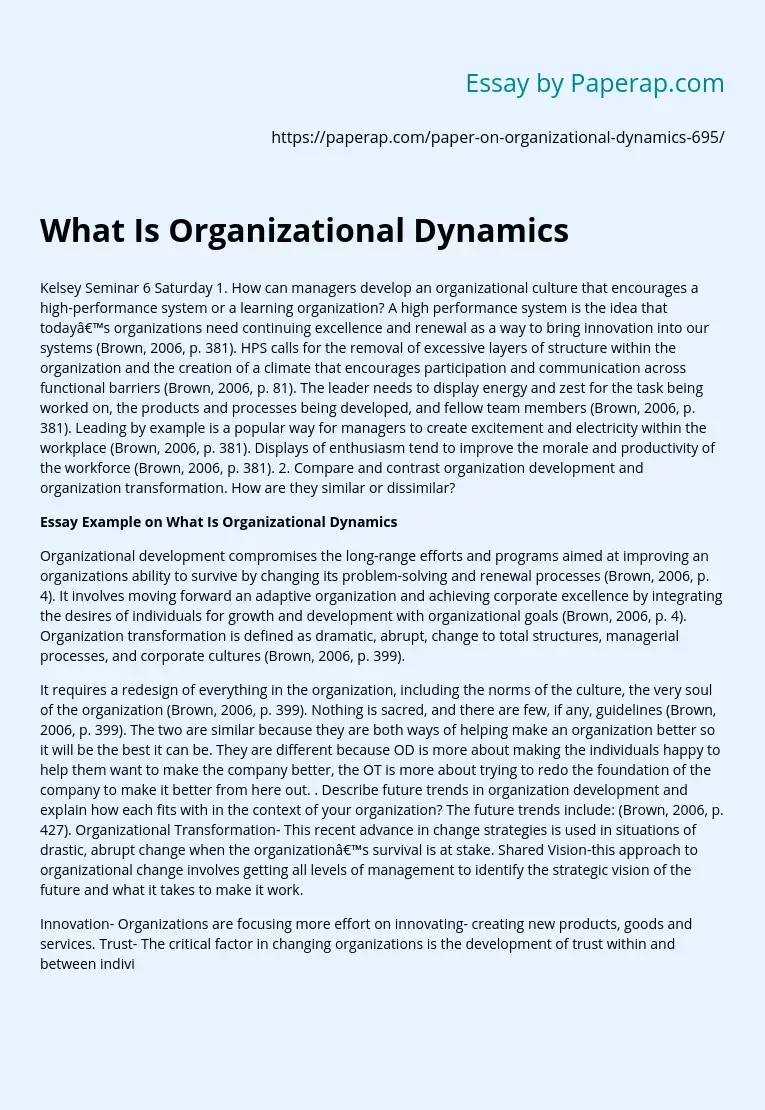What Is Organizational Dynamics
Kelsey Seminar 6 Saturday 1. How can managers develop an organizational culture that encourages a high-performance system or a learning organization? A high performance system is the idea that today’s organizations need continuing excellence and renewal as a way to bring innovation into our systems (Brown, 2006, p.
381). HPS calls for the removal of excessive layers of structure within the organization and the creation of a climate that encourages participation and communication across functional barriers (Brown, 2006, p. 81). The leader needs to display energy and zest for the task being worked on, the products and processes being developed, and fellow team members (Brown, 2006, p. 381). Leading by example is a popular way for managers to create excitement and electricity within the workplace (Brown, 2006, p. 381). Displays of enthusiasm tend to improve the morale and productivity of the workforce (Brown, 2006, p. 381). 2. Compare and contrast organization development and organization transformation. How are they similar or dissimilar?
Essay Example on What Is Organizational Dynamics
Organizational development compromises the long-range efforts and programs aimed at improving an organizations ability to survive by changing its problem-solving and renewal processes (Brown, 2006, p. 4). It involves moving forward an adaptive organization and achieving corporate excellence by integrating the desires of individuals for growth and development with organizational goals (Brown, 2006, p. 4). Organization transformation is defined as dramatic, abrupt, change to total structures, managerial processes, and corporate cultures (Brown, 2006, p. 399).
It requires a redesign of everything in the organization, including the norms of the culture, the very soul of the organization (Brown, 2006, p. 399). Nothing is sacred, and there are few, if any, guidelines (Brown, 2006, p. 399). The two are similar because they are both ways of helping make an organization better so it will be the best it can be. They are different because OD is more about making the individuals happy to help them want to make the company better, the OT is more about trying to redo the foundation of the company to make it better from here out. . Describe future trends in organization development and explain how each fits with in the context of your organization? The future trends include: (Brown, 2006, p. 427). Organizational Transformation- This recent advance in change strategies is used in situations of drastic, abrupt change when the organization’s survival is at stake. Shared Vision-this approach to organizational change involves getting all levels of management to identify the strategic vision of the future and what it takes to make it work.
Innovation- Organizations are focusing more effort on innovating- creating new products, goods and services. Trust- The critical factor in changing organizations is the development of trust within and between individuals, teams, and organizational units and levels. Empowerment- In order to develop high-performing systems, organization members must be empowered. Learning organization- a conceptual framework for the organization of the future, the learning organization is the notion that learning is central to success. Reengineering- The fundamental rethinking and radical redesigning of business ystems urges an overhaul of job designs, organizational structures, and management systems. Core Competences- the idea for companies to identify and organize around what they do best. Organizational Architecture- a metaphor that forces managers to think more broadly about their organization in terms of how work, people and formal and informal structures fit together. Reference Brown, D. R. & Harvey, D. (2006). An experiential approach to Organizational development, (7th ed. ). ,Upper Saddle River, N J: Prentice Hall.
What Is Organizational Dynamics. (2019, Nov 27). Retrieved from https://paperap.com/paper-on-organizational-dynamics-695/

